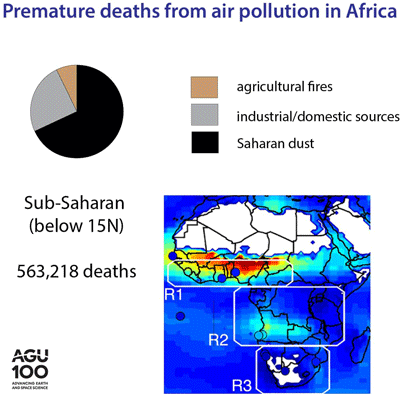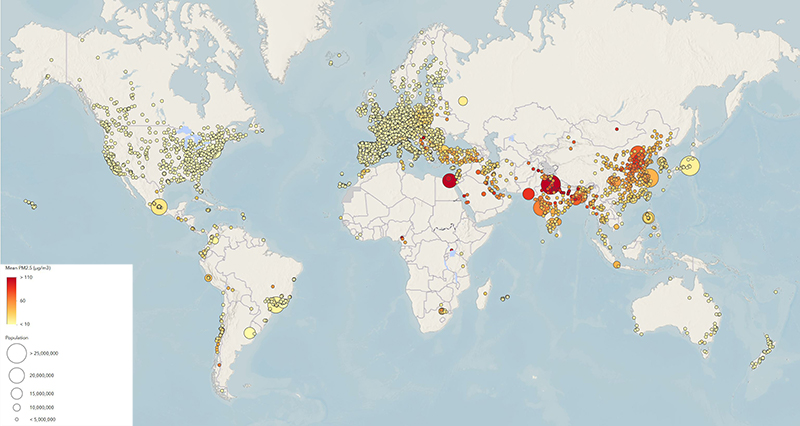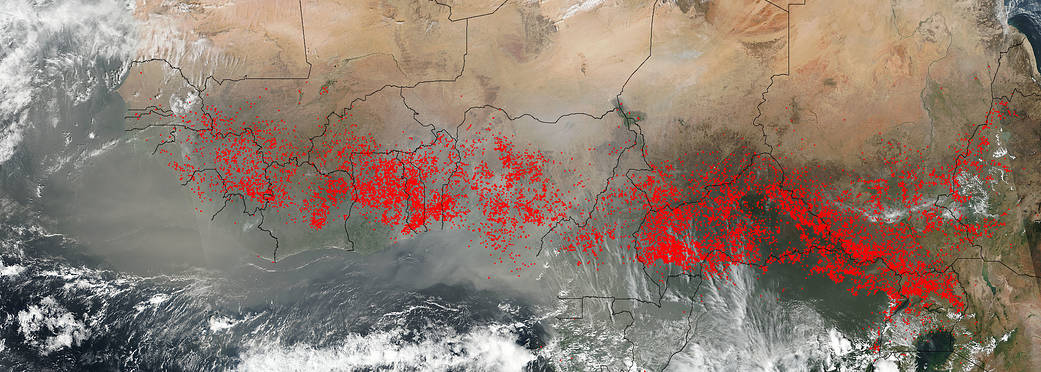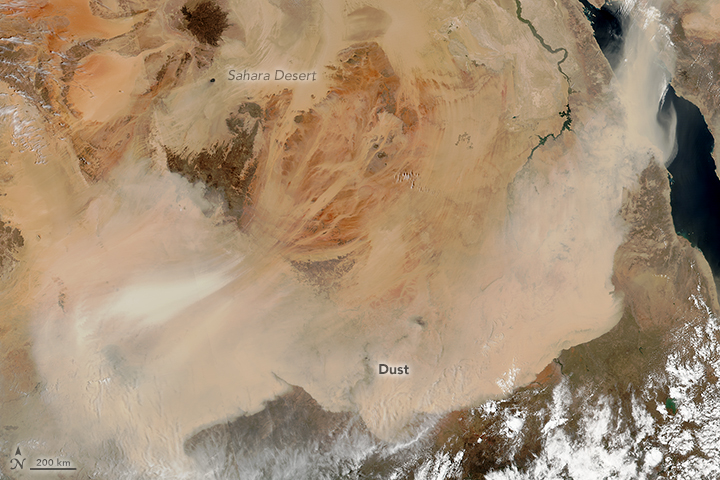16 April 2019
Dust toll in Africa exceeds deaths from HIV
Posted by llester
Mineral dust from the Sahara is the biggest contributor to air pollution-related premature deaths on the African continent
By Liza Lester
 In Africa, air pollution causes the premature deaths of about 780,000 people each year, potentially more than HIV infection, a new study estimates.
In Africa, air pollution causes the premature deaths of about 780,000 people each year, potentially more than HIV infection, a new study estimates.
Mineral dust from the Sahara desert is the largest contributor to air quality-related mortality on the continent overall according to the new study in AGU’s Journal of Geophysical Research: Atmospheres.
“It’s just the sheer amount of material and also how it co-locates with the densely populated parts of Western Africa. These two things together make mineral dust a bigger health threat than anything that’s anthropogenic or coming from the industrial development,” said Susanne Bauer, a researcher specializing in aerosols and climate modeling at NASA’s Goddard Institute for Space Studies in New York, and the lead author of the new study.
The new study used global climate models to simulate particulate and ozone pollution throughout the continent, combined with health models to estimate outcomes for exposed populations. Air pollution monitoring is sparse in Africa, but the authors found their modeling results fit the limited data available. The new study is an effort to help bridge that information gap through modeling.
The new study differs from previous studies by quantifying contributions from natural and anthropogenic sources and accounting for climate feedbacks from human industry. Emissions from human activities can change the location and frequency of dust storms, for example.
The relative risk from natural, industrial, and agricultural sources of pollution varies regionally. Agricultural practices, industrial development, population, distance from the desert and prevailing winds all contribute to risk.

Measurements of annual mean ambient PM2.5 concentrations (micrograms/cubic meter), updated in 2018. Air pollution data for the African continent is limited by scarcity of monitoring stations.
Credit: World Health Organization
In West Africa, wind-carried dust from the desert is responsible for about 40 percent of premature deaths from air pollution, whereas in Southern Africa, dust has a negligible impact and industrial and domestic sources of air pollution cause nearly 90 percent of premature deaths, according to the new study. Smoke from agricultural fires is responsible for more than 50 percent of premature deaths from bad air in Central Africa, the study found.
Nigeria experiences the deadliest air pollution on the continent thanks to a triple threat from desert dust, dense industrialization and smoke from agricultural fires in the West Africa region. Nigeria is also the most populous nation in Africa, with more than 190 million residents.
“Nigeria is maybe a country that should worry about this, and a country that can afford to worry about it,” Bauer said.
Deadly air
Both particulates and ground-level ozone contribute to air pollution. At high concentrations, ozone, produced on the ground by vehicles, fires, and industrial processes, triggers asthma, constricts lung function, and can cause lung disease.
Particulate air pollution is a problem worldwide. More than 90 percent of people breath air that exceeds safe guidelines, according to the World Health Organization. Breathing fine particles smaller than 2.5 micrometers is known to damage human health, causing or worsening cardiovascular and respiratory disease, asthma and stroke.
These microscopic particles, also known as PM2.5, are small enough to burrow through lung tissue and get into the bloodstream. Inhaled fine particles can also increase exposure to other dangerous chemicals. Though too small see, these particles have plenty of surface area to collect and transport toxins into the body.

Hundreds of fires smoldered across Central Africa on 27 December, 2017, as farmers burned the residue of the previous season’s crops.
Credit: Jeff Schmaltz/NASA
Smoke and soot from fire is major source of particulate pollution. Burning brush and agricultural fields is so prevalent after harvest in Central Africa, and in winter in Western Africa, that the smoke plumes are visible from space. The dramatic plumes motivated the initiation of the new study.
Though responsible for an estimated 43,000 premature deaths per year, biomass burning does not affect as many people as wind-blown desert dust because the population in Central Africa is relatively low.
“So my big motivation to do the study, the agricultural burning effect, turned out to be the smallest killer African-continent wise. But that doesn’t mean for the people who live in there, in Central Africa, it’s not important,” Bauer said.
Bauer says providing people with information about their risk from air pollution is essential to empowering them to protect themselves. Agricultural fires and dust storms can be predicted and prepared for. Anthropogenic pollution can be regulated. Even intractable natural sources like massive dust storms from the Sahara desert can mitigated by face masks or limiting time outside.

Wind-driven sandstroms, or haboobs, from the Sahara shut down airports and schools in Egypt and Sudan in March 2018.
Credit: Jeff Schmaltz/NASA
— Liza Lester is a public information specialist and writer at AGU. Follow her on twitter @lizalester.



 GeoSpace is a blog on Earth and space science, managed by AGU’s Public Information staff. The blog features posts by AGU writers and guest contributors on all sorts of relevant science topics, but with a focus on new research and geo and space sciences-related stories that are currently in the news.
GeoSpace is a blog on Earth and space science, managed by AGU’s Public Information staff. The blog features posts by AGU writers and guest contributors on all sorts of relevant science topics, but with a focus on new research and geo and space sciences-related stories that are currently in the news.